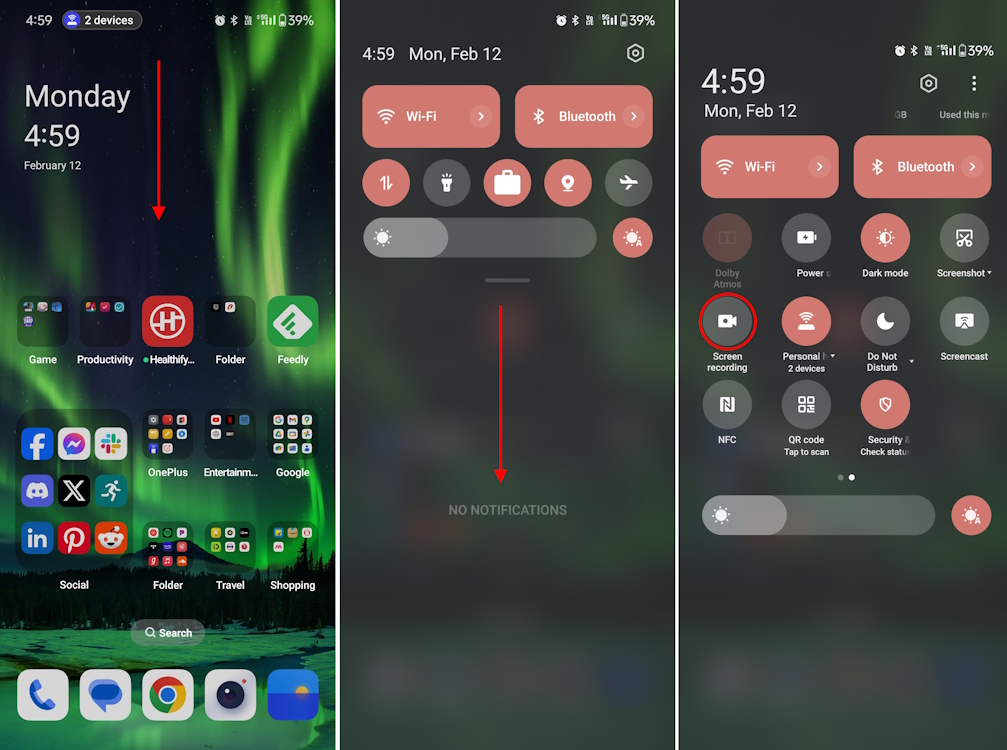- Most Android devices come with native screen recorders; so you don't need a third-party app to record something.
- To start recording, swipe down to access the quick access panel and tap on the Screen recording icon.
- You can also use third-party apps like XRecorder to get more control over video quality and frame rate.
Gone are the days when you would have to solely rely on a third-party app to screen record on an Android device. Screen recording on Android has been a breeze since Android 11. Whether you’re new to Android or just forgot how to do it, this guide will have you recording the Android screen in no time. Let’s dive in!
Record Screen Using Native Android Recorder
The native Android screen recorder is easy to access. Moreover, it won’t matter which smartphone brand you are using as it is similar on every Android device. All you have to make sure is that your device is running on Android 11 (since the built-in screen recorder was introduced with this Android version) or above.
So, to outline the steps, we are using a OnePlus 11R running on Android 14. Here’s a quick rundown:
- Launch the Quick Settings panel on your Android device by swiping down twice on the home screen.
- From here, locate and tap on the Screen recording tile from this panel. This option will have a slightly different name depending on the device you’re using.

- That will trigger a brief countdown, after which the recording will start. You’ll see the duration of the recording inside a pill-shaped icon in the status bar at the top.
- If you can’t see the screen recorder tile, enter the Quick Settings panel’s edit mode and add the tile to the front. Here’s a GIF demonstrating this process.
- On OnePlus’ OxygenOS 14, you will see a small Dynamic-Island-like recording icon appear at the top. Tapping on this icon will reveal a recording toolbox. Or, you can swipe down from the top to reveal the notification tray, where you will see the recording toolbox. Once you are done recording your screen, tap on Done from the notification tray.
- You can also long-press on the tile to head over to the native screen recorder settings. Here, you can tweak the recording quality, Frame rate, video coding format, and more.
Note: You can only tweak the screen recorder settings before starting the recording. You can’t change settings in between a recording.
Of course, devices from different brands will have certain minor differences on the interface level. To make things easier, we have used our resources at the Beebom office to show you how the option looks across the different Android skins:
However, some smartphones like the Pixel lineup do not offer settings like the ability to change your video quality or frame rate. In that case, falling back on a third-party screen recorder is your next best bet. That brings us to the next section.
Record Screen Using Third-Party Apps
Now, there are quite a few Android screen recording apps out there. However, finding a reliable option may be troublesome. So, to make things easier, we would recommend using either the XRecorder third-party Android app.
The app offers you a bunch of different settings to tweak and get the best possible output. Of course, certain settings like recording at 60 FPS require a subscription to the paid tier. Otherwise, it’s all good, and here’s how to use the app to record your Android screen:
- Install the XRecorder app on your device from the Google Play Store.
- Now, open the XRecorder app and tap on Enable floating icon to allow recording from any app. When you do that, you’ll get into the Display over other apps screen.
- Here, scroll down and select XRecorder from the list of apps. Then, turn ON the Display over other apps toggle.
- Get back into the app and tap on Allow to grant the necessary permissions required for the app to function well.
- Then, tap on the Record button at the bottom right corner. The app will now ask you to grant it microphone access. For this, select While using the app from the popup menu. If you don’t allow this, XRecorder will not record any audio with your video.
- On the next menu, select Start now to start recording your screen.
- From the recording toolbox at the bottom right corner, tap on the square icon to stop recording.
- On the next screen, you can use the on-screen options to delete, edit, or share the screen recording.
- You will also see a floating record icon. Tap on this icon to quickly record your screen or tweak the recorder settings.
- To close the floating window, long-press on the floating icon and drag it toward the cross button that appears on the bottom half of the screen.
With that, we hope you now know how to screen record on your Android device like a pro. Now, if you are on an iOS device instead, check this guide out to know how to screen record on it. However, if you do run into any issues, feel free to comment down below.